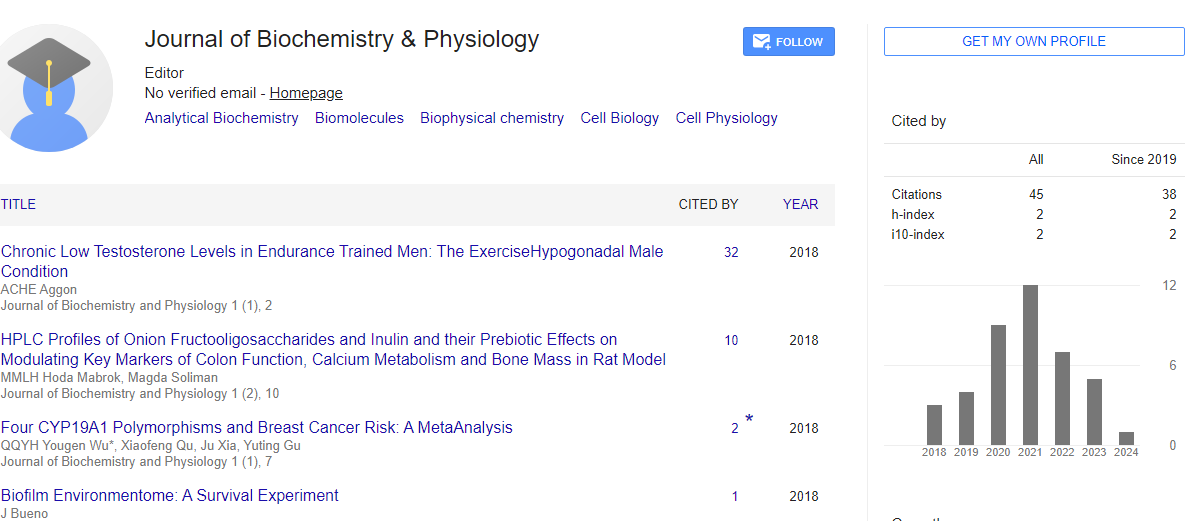Opinion Article, J Biochem Physiol Vol: 6 Issue: 2
Acid-Sensing Receptor in Panic Disorder
Andrew Varney*
1Department of Psychiatry, University of New Mexico School of Medicine, Albuquerque, United States of America
*Corresponding Author: Andrew Varney,
Department of Psychiatry ,University of
New Mexico School of Medicine, Albuquerque, United States of America
E-mail: varneyad@uc.edu
Received date: 29 May, 2023, Manuscript No JBPY-23-110459;
Editor assigned date: 31 May, 2023, PreQC No. JBPY-23-110459 (PQ);
Reviewed date: 14 June, 2023, QC No. JBPY-23-110459;
Revised date: 21 June, 2023, Manuscript No. JBPY-23-110459 (R);
Published date: 28 June, 2023 DOI: 10.4172/jbpy.1000134.
Citation: Varney A (2023) Acid-Sensing Receptor in Panic Disorder. J Biochem Physiol 6:2.
Abstract
Everyone feels anxious and panicky in stressful or perilous circumstances. Sudden panic or fear attacks are a symptom of panic disorder. Panic attacks happen to those who have panic disorder. Women are more susceptible to this illness in their late teens or early adulthood. Psychiatric disorders vary widely, although panic disorder is quite uncommon. Substances referred to as panicogens can cause sickness. It happens for a variety of causes such as genetics, extreme stress, and modifications in brain function. Proton-gated cationic ion channels known as Acid-Sensing Ion Channels (ASICs) are mostly expressed in the central and peripheral nervous systems. ASICs are used to keep track of pathological and physiological signals.
Description
Everyone feels anxious and panicky in stressful or perilous circumstances. Sudden panic or fear attacks are a symptom of panic disorder. Panic attacks happen to those who have panic disorder. Women are more susceptible to this illness in their late teens or early adulthood. Psychiatric disorders vary widely, although panic disorder is quite uncommon. Substances referred to as panicogens can cause sickness. It happens for a variety of causes such as genetics, extreme stress, and modifications in brain function. Proton-gated cationic ion channels known as Acid-Sensing Ion Channels (ASICs) are mostly expressed in the central and peripheral nervous systems. ASICs are used to keep track of pathological and physiological signals.
ASICs, or Acid-Sensing Ion Channels, are members of the DeGeneres/Epithelial Sodium Channel superfamily (DEG/ENaC). ASIC1a, ASIC1b, ASIC2a, and ASIC3 constitute the channel pore in these channels, which also contain two additional proteins (ASIC2b and ASIC4) but no known activators. Primary sensory neurons are where the majority of these molecular acid sensors are expressed. ASICs include the transient receptor potential vanilloid-1 (TRPV1), the Amiloride-Sensitive Cation Channel (ACCN), and the T-cell death-associated gene 8 (TDAG8). The partial pressure of CO2 in the blood rises with CO2 inhalation, which also decreases pH levels throughout the body. Therefore, it is anticipated that the CO2 provocation challenges utilized in psychiatric research will abruptly and briefly lower brain pH.
ASICs, or Acid-Sensing Ion Channels, are members of the DeGeneres/Epithelial Sodium Channel superfamily (DEG/ENaC). ASIC1a, ASIC1b, ASIC2a, and ASIC3 constitute the channel pore in these channels, which also contain two additional proteins (ASIC2b and ASIC4) but no known activators. Primary sensory neurons are where the majority of these molecular acid sensors are expressed. ASICs include the transient receptor potential vanilloid-1 (TRPV1), the Amiloride-Sensitive Cation Channel (ACCN), and the T-cell death-associated gene 8 (TDAG8). The partial pressure of CO2 in the blood rises with CO2 inhalation, which also decreases pH levels throughout the body. Therefore, it is anticipated that the CO2 provocation challenges utilized in psychiatric research will abruptly and briefly lower brain pH.
The significance of acid-base and chemosensory systems in panic offers solid scientific insights on the origin of unprovoked panic attacks, which may make fear-arousal-stress regulatory circuits more sensitive to other stimuli and result in fully developed PD. Acid/base imbalances or altered chemosensory processes that pose a "threat to homeostasis" may be the cause of initial surprise attacks. Although the precise cause of pH disturbance is unknown, it could be brought on by genetic predisposition, anomalies in the respiratory system, and other causes. This could result in a state of alert and the subsequent activation of danger response mechanisms, which would then cause higher fear and other phenomenologically-defined symptoms of a panic attack, such as symptoms of the heart and lungs.
Additionally, having uncured panic attacks might make your danger response systems more sensitive to exteroceptive triggers like stress, panic context, and related phobic signals, which can then cause cued panic attacks. The effectiveness of benzodiazepines, particularly alprazolam and clonazepam, has also been demonstrated in PD. Additionally, the best researched psychotherapy for Parkinson's disease appears to be comparable to medicine in the treatment of PD, Cognitive-Behavioral Therapy (CBT). Treatment plans for PD patients can be tailored to each patient's preferences for medication or psychotherapy, past responses, the presence of concomitant conditions, and the severity of their symptoms.
10 mg or 25 mg of paroxetine, fluoxetine, or sertraline each day as antidepressants. This dosage is maintained for a few days before being increased to the typical SSRI daily levels, such as 20 mg of paroxetine or fluoxetine. SSRIs, including paroxetine and sertraline, are regarded as first-line therapies. SSRIs are a suitable option for patients who are willing to put up with a delay of several weeks before the medication starts to work because they are efficient, have a positive side effect profile, little danger of dependence, and only cause a small number of drug interactions.
 Spanish
Spanish  Chinese
Chinese  Russian
Russian  German
German  French
French  Japanese
Japanese  Portuguese
Portuguese  Hindi
Hindi 